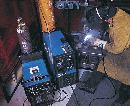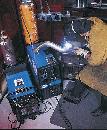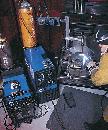
by Tim Fox, product manager, Miller Electric Mfg. Co.
Stationed in the welding cells at a new Morgan Hill, Calif., factory are 14 Miller Electric welding units, an even blend of TIG and MIG machines giving each cell the capability of helping fabricate a variety of performance car parts.
The components, once they are installed at a dealership, specialty shop or home garage, bring already-sleek BMWs into a new plane of existence–the “Dinan Zone.” Dinan develops and manufactures a variety of engine, driveline and chassis tuning parts for BMWs that dramatically increase the vehicles’ power, responsiveness and handling.
Dinan’s customers are people who want a high-end car, but don’t want to shed the idea that they should be driving a hot rod, says Dinan CEO and founder, Stephen J. Dinan. “A lot of our clients are 50-year-old guys with adolescent dreams. They desire a nice car, but they also want the old hot rod thing–like the Chevys and Camaros they had when they were kids. However, they also want it to last a long time–they demand a warranty. We’re the place they come to.”
Dinan’s warranty matches whatever period remains on the original manufacturer’s new-car warranty for up to four years/50,000 miles.
From Mechanic to Entrepeneur
Dinan started his business 24 years ago, pursuing an intense interest in cars and motorcycles that had steered him to work as a foreign car mechanic while moonlighting as an engineering student taking auto tech courses at De Anza College in Cupertino.
“I finally got a job as a mechanic at A&E Performance, a BMW shop in Campbell, Calif.,” he says. “I really liked the way these cars were put together. I remember thinking these are cars that are engineered correctly. So I quit my job, dropped out of college, took my Miller Dialarc® 250 AC/DC welder home to my garage in Cupertino and started making parts.”
The first component Dinan made actually came before that, while he was still employed at A&E. It was an eccentric bolt that makes the vehicle’s rear camber adjustable. The complete camber adjustable rear subframe kit allows camber position fine-tuning when the car’s owner chooses to lower the suspension to improve road grip while cornering. “BMWs come with fixed alignment in the rear if the car is made perfect,” he explains. “When you lower the suspension, the tires wear on the inside edge, compromising the vehicle’s safety and handling. The kit corrects this problem.”
The camber kit became part of Dinan’s chassis tuning line and remained there until recently. “All new BMWs are rear camber adjustable now, so this product is slowing down in volume for us, but we still sell enough of them. We talked just a few days ago about doing one more production run on them before we extinguish it,” Dinan says.
The camber kit is on the low-tech end of what Dinan offers. Today’s full line of Dinan products is as high-tech as it is broad. Engine tuning options include performance software, high flow cold air intake systems, free flow exhausts, high flow throttle bodies, high flow air flow meters, supercharger systems and high flow intake and exhaust manifolds. Driveline tuning products encompass limited slip differentials, modified final drive gearing and lightweight performance clutch assemblies. Chassis tuning alternatives include strut and shock tower braces, performance suspension systems and brake conversions.
BMW owners can select any or all available components piecemeal for their vehicles to create a tailor-made blend of power and handling or opt for a package deal in one of a wide variety of Dinan Signature Vehicles.
Two Machines Per Cell for Maximum Productivity
From mufflers and cold air intake systems to suspension components, supercharger systems and high flow intake manifolds–each with several aluminum or stainless steel subparts–Dinan has ample need for high-quality, high-output and flexible welding capacity.
Dinan equips each welding cell with both a MIG and a TIG welding machine. MIG welding is by far the faster process, thereby resulting in higher productivity. TIG welding is more precise and produces a weld bead with better appearance, but it is much slower and more exacting. Thus, many components are welded with both processes. The dual exhaust outlets on a muffler, for example, are welded around their circumference–until their proximity prohibits access between them. Dinan fabricators then use a TIG machine to weld between the outlets, as well as smooth out any imperfections and fill in pin holes. Accordingly, as the company was ramping up a new workshop in Morgan Hills, Dinan was in the market for welding power sources to equip his plant’s seven welding cells.
Since fabricating many products requires both the MIG and TIG process, Dinan wanted to equip each cell with both types of units. As a businessman, he knew that tactic produced a better return on investment than sharing units among fabrication stations.
“As a young mechanic, I worked in shops that didn’t have equipment I needed, such as a lift, to complete the job,” he recalls. “I started clocking how much time I was forced to waste waiting for equipment.”
The BMW’s reputation for precision definitely suits Dinan because he still clocks work flow and calculates the cost of different production methods for “every single piece of equipment that we own in the whole business. For example, when people need to share welding equipment, they waste an hour each day moving the unit around, changing wire spools, and so on. I value labor time at $100 an hour, and there are 21 working days in a month, so that’s $2,100 wasted every month through process inefficiency. It makes no sense, yet many people hesitate to invest in two welding systems per cell because they think it’s going to break the bank. It’s just not true.”
Bruce Tozer, corporate vice president for Arc Gas Products, Inc., San Jose, Calif., explains, “Dinan leases the welders for $200 to $300 per month, per machine, through an arrangement with a finance company. As soon as Steve calculated an $1,800 positive return on investment, he called us to acquire the Miller machines.”
But Which Machines?
Dinan assigned the equipment selection task largely to Chris Bennett, an experienced welder/fabricator.
“I chose six Millermatic® 185 MIG welders, six Syncrowave® 180 SD TIG machines and one Syncrowave 250. I also had the opportunity to test the new Millermatic 210,” Bennett says. “I’ve used a lot of different machines, and I favor Miller over any other machines because of their proven reliability and performance. I could immediately tell that the Millermatic 210 has a superior drive roll system for a steadier arc. I’ve got plenty of current right where I need it.”
These machines make sense because they maintain Dinan’s quality standards, yet are affordable–the cost for equipping a cell with both units is about $3,000, not including accessories.
Bennett says, “The Miller welders seemed to be a good fit with what we’re doing here, which mostly involves MIG and TIG welding 304 stainless steel in thicknesses up to .060 in. For thicker aluminum, such as 3/8- or 1/4-in. plate (6061 grade), we use the Syncrowave 250; otherwise, we use the Syncrowave 180 SD.”
With a welding range of 30 to 210 amps (160 amps at 60 percent duty cycle), the Millermatic 210 offers 10 amps more power than any comparable machine at any duty cycle. Bennett and other Dinan operators can easily fine tune the arc to obtain best-of-class performance on metals as thin as 22 gauge (.031 in.) or as thick as 3/8 in.
“I had no problem setting up the Millermatic 210,” says Bennett, “plus I’m kind of impressed that it goes to seven” voltage taps for a wider welding range.
Bennett also appreciated the unit’s built-in dual gun/cable holder and consumables compartment.
“A clean work area improves safety, and the gun/cable holder keeps the cables off the floor so I don’t trip over them,” he says.
The Syncrowave 180 SD is an AC/DC with TIG and Stick welding capabilities and a 10- to 180-amp output range (150 amps at 40 percent duty cycle). It features Miller’s squarewave AC arc technology for the smoothest arc in its class. A built-in high frequency arc starter and stabilizer provide positive arc starts without wandering and a more consist arc while welding.
The “Laboratory”
Dinan’s new facility in Morgan Hill is a factory only in a general sense. It is more akin to a BMW parts laboratory in which fabricators spend months developing and prototyping components and additional months evaluating the prototypes in test cells and test-driving the installed experimental parts in Dinan-owned BMWs.
“Once we’re done making everything we’re going to make for the car, we send it to auto magazines like Road & Track and Car and Driver and have them do a road test, the results of which they’ll use to write a report for the publication,” Dinan says.
Long before the latest Dinan masterpiece attains glory in print, the entire process begins modestly with a prototype version of the component. Engineers then take the part and draw it on one of Dinan’s three CAD systems to create a digital file of the part’s various pieces. The file subsequently heads to a vendor to have stampings or CNC parts fabricated. Back at Dinan, engineers, welders and other specialists bolt or weld the pieces together into the finished prototype.
“We have the vendor send us only the unassembled pieces of the component,” Dinan emphasizes. “When we control the design, we want to be able to QC the products before they go together.”
For example, in late 2001 the company was deep into evaluations of a prototype exhaust header for the BMW M5. The header is composed of 20 gauge 304 stainless steel and required separate fixtures to be MIG-welded together–part of a four-month fabrication and construction process that began in late 2000. Dinan had subjected the experimental product to three months of computer analysis for combustion attributes and four months of dynomometer time to assess its performance. Like many of Dinan’s engine tuning products, the header injects additional power into its host, in this case 28 horsepower on a 400 horsepower engine.
“We want to be able to make running changes,” says Dinan. “If we rely on someone else to make finished goods, then we’re at their mercy as to what they choose to do, and we don’t want to be at their mercy.”
Dinan supercharger systems, another marquee engine tuning category, also require precision welds. Employing forced induction engine technology, these systems feature a Vortech supercharger, 8-rib belt, and a reprogrammed engine management system for maximum power gains, driveability and compliance with emissions standards.* These systems also have an aggressive cold air intake, enabling the supercharged engine to breathe ample cool air for the greatest power boost.
Dinan says the prototype supercharger system for 1999-2002 BMW 540s adds more than 100 horsepower to the stock vehicles’ 282 horsepower engine.
Dinan’s suspension systems highlight the company’s line of chassis tuning products. Dinan Sport and Performance-tuned Suspension Systems help BMWs’ tires stick to the pavement, while maintaining a civilized ride. The springs and shocks work together to enable the BMW to hug the road and remain composed, resulting in flatter cornering, better traction and more predictable handling. Larger, adjustable front and rear anti-roll bars further reduce body roll and allow the vehicle owner to fine-tune the system to personal driving style. Camber plates deliver a higher level of performance handling by reducing understeer or the car’s tendency to push straight ahead instead of turning in. Three suspension systems, from Sport to Performance, are available. Each offers a stronger dose of cornering capability and sophistication.
Dinan boasts a nationwide network of 98 authorized retailers that sell and install Dinan Performance Products. “Dinan modifications are made to three or four percent of the 200,000 BMWs sold each year,” he says. “That’s 6,000 to as many as 8,000 additional Dinan-enhanced BMWs on the road every year.”
(For more information on Miller’s welding products, visit www.MillerWelds.com. For more information on Dinan’s BMW components, visit www.dinanbmw.com.)
*Most Dinan products have been tested and are 50-state emissions legal. Testing of Dinan products for emission legal status is an ongoing process.


